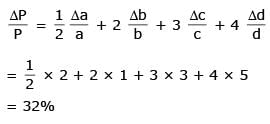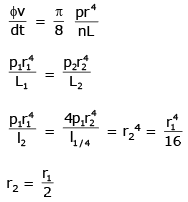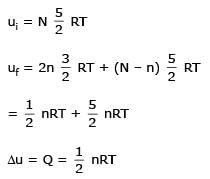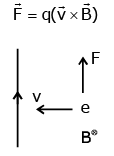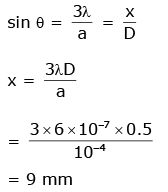JEE Main 2017 April 9 Paper & Solutions - JEE MCQ
30 Questions MCQ Test - JEE Main 2017 April 9 Paper & Solutions
A physical quantity P is described by the relation P a1/2 b2 c3 d−4 If the relative errors in the measurement of a, b, c and d respectively, are 2%, 1%, 3% and 5%, then the relative error in P will be:
A car is standing 200 m behind a bus, which is also at rest. The two start moving at the same instant but with different forward accelerations. The bus has acceleration 2 m/s2 and the car has acceleration 4 m/s2. The car will catch up with the bus after a time of:
Two particles A and B of equal mass M are moving with the same speed v as shown in the figure. They collide completely inelastically and move as a single particle C. The angle θ that the path of C makes with the X-axis is given by:


The machine as shown has 2 rods of length 1 m connected by a pivot at the top. The end of one rod is connected to the floor by a stationary pivot and the end of the other rod has a roller that rolls along the floor in a slot. As the roller goes back and forth, a 2 kg weight moves up and down. If theroller is moving towards right at a constant speed, the weight moves up with a:
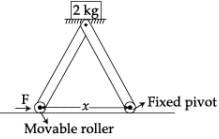
A conical pendulum of length 1 m makes an angle θ=45o w.r.t. Z-axis and moves in a circle in the XY plane. The radius of the circle is 0.4 m and its center is vertically below O. The speed of the pendulum, in its circular path, will be: (Take g=10 ms−2)
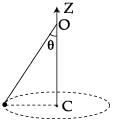
A circular hole of radius R/4 is made in athin uniform disc having mass M and radius R, as shown in figure. The moment of inertia of the remaining portion of the disc about an axis passing through the point O and perpendicular to the plane of the disc is:
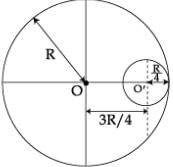
The mass density of a spherical body is given by ρ (r) = k/r for r ≤ R and ρ (r)=0 for r > R, where r is the distance from the centre. The correct graph that describes qualitatively the acceleration, a, of a test particle as a function of r is:
A steel rail of length 5 m and area of cross-section 40cm2 is prevented from expanding along its length while the temperature rises by 10oC. If coefficient of linear expansion and Young’s modulus of steel are 1.2×10−5 K−1 and 2×1011 Nm−2 respectively, the force developed in the rail is approximately :
Two tubes of radii r1 and r2, and lengths l1 and l2, respectively, are connected in series and a liquid flows through each of them in stream line conditions. P1 and P2 are pressure differences across the two tubes.
If P2 is 4P1 and l2 is l1/4 , then the radius r2 will be equal to:
For the P-V diagram given for an ideal gas,
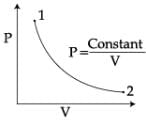
out of the following which one correctly represents the T-P diagram?
N moles of a diatomic gas in a cylinder are at a temperature T. Heat is supplied to the cylinder such that the temperature remains constant but n moles of the diatomic gas get converted into monoatomic gas. What is the change in the total kinetic energy of the gas?
A block of mass 0.1 kg is connected to an elastic spring of spring constant 640 Nm−1 and oscillates in a damping medium of damping constant 10−2 kg s−1. The system dissipates its energy gradually. The time taken for its mechanical energy of vibration to drop to half of its initial value, is closest to :
A standing wave is formed by the superposition of two waves travelling in opposite directions. The transverse displacement is given by y(x,t) = 0.5 sin  cos(200 πt). What is the speed of the travelling wave moving in the positive x direction? (x and t are in meter and second, respectively.)
cos(200 πt). What is the speed of the travelling wave moving in the positive x direction? (x and t are in meter and second, respectively.)
Four closed surfaces and corresponding charge distributions are shown below.


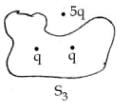
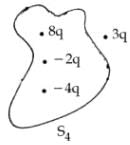
Let the respective electric fluxes through the surfaces be Φ1, Φ2, Φ3 and Φ4. Then:
A combination of parallel plate capacitors is maintained at a certain potential difference.

When a 3 mm thick slab is introduced between all the plates, in order to maintain the same potential difference, the distance between the plates is increased by 2.4 mm. Find the dielectric constant of the slab.
A uniform wire of length l and radius r has a resistance of 100 Ω. It is recast into a wire of radius r/2. The resistance of new wire will be:
The figure shows three circuits I, II and III which are connected to a 3V battery. If the powers dissipated by the configurations I, II and III are P1, P2 and P3 respectively, then:
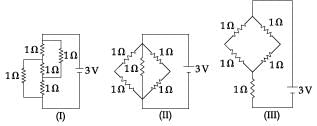
A negative test charge is moving near a long straight wire carrying a current. The force acting on the test charge is parallel to the direction of the current. The motion of the charge is :
A uniform magnetic field B of 0.3 T is along the positive Z-direction. A rectangular loop (abcd) of sides 10 cm×5 cm carries a current I of 12 A. Out of the following different orientations which one corresponds to stable equilibrium?
A sinusoidal voltage of peak value 283 V and angular frequency 320/s is applied to a series LCR circuit. Given that R=5 Ω, L=25 mH and C=1000 µF. The total impedance, and phase difference between the voltage across the source and the current will respectively be :
The electric field component of a monochromatic radiation is given by  cos kz cos ωt
cos kz cos ωt
In an experiment a convex lens of focal length 15 cm is placed coaxially on an optical bench in front of a convex mirror at a distance of 5 cm from it. It is found that an object and its image coincide, if the object is placed at a distance of 20 cm from the lens. The focal length of the convex mirror is:
A single slit of width 0.1 mm is illuminated by a parallel beam of light of wavelength 6000 Å and diffraction bands are observed on a screen 0.5 m from the slit. The distance of the third dark band from the central bright band is:
A Laser light of wavelength 660 nm is used to weld Retina detachment. If a Laser pulse of width 60 ms and power 0.5 kW is used the approximate number of photons in the pulse are:
[Take Planck’s constant h=6.62×10−34 Js]
The acceleration of an electron in the first orbit of the hydrogen atom (n=1) is :
Imagine that a reactor converts all given mass into energy and that it operates at a power level of 109 watt. The mass of the fuel consumed per hour in the reactor will be: (velocity of light, c is 3×108 m/s)
The current gain of a common emitter amplifier is 69. If the emitter current is 7.0 mA, collector current is :
A signal is to be transmitted through a wave of wavelength λ, using a linear antenna. The length l of the antenna and effective power radiated Peff will be given respectively as:
(K is a constant of proportionality)
In a meter bridge experiment resistances are connected as shown in the figure. Initially resistance P=4 Ω and the neutral point N is at 60 cm from A. Now an unknown resistance R is connected in series to P and the new position of the neutral point is at 80 cm from A. The value of unknown resistance R is :
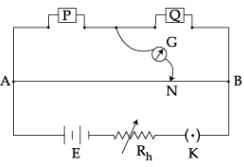
In an experiment to determine the period of a simple pendulum of length 1 m, it is attached to different spherical bobs of radii r1 and r2. The two spherical bobs have uniform mass distribution. If the relative difference in the periods, is found to be 5×10−4 s, the difference in radii, |r1−r2| is best given by:


